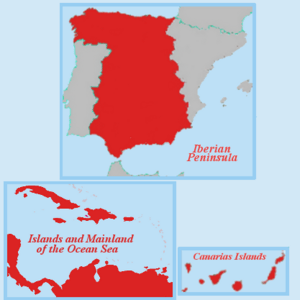Treaty of Villafáfila facts for kids

The Treaty of Villafáfila was an important agreement signed in Spain in 1506. It was signed by two powerful rulers: Ferdinand the Catholic and Philip the Handsome. Ferdinand signed it in a town called Villafáfila on June 27, 1506. Philip signed it the next day in Benavente, Zamora.
This treaty dealt with who would rule the kingdom of Castile. It was about the power struggle between Ferdinand, Philip, and Ferdinand's daughter, Joanna the Mad.
Contents
Why Was the Treaty Needed?
The treaty was made because of Queen Joanna the Mad. She was the daughter of Ferdinand and Queen Isabella. Isabella had ruled Castile before she passed away.
Joanna's Role in Castile
When Queen Isabella died, Joanna became the new Queen of Castile. However, people believed Joanna was not able to rule by herself. Her father, Ferdinand, was supposed to help her as a regent. A regent is someone who rules a country when the king or queen cannot.
Philip's Claim to Power
Philip was Joanna's husband. He was also known as Philip the Handsome. Philip wanted to share the power in Castile. He did not want Ferdinand to be the only ruler. This led to disagreements between Ferdinand and Philip.
What the Treaty Decided
The Treaty of Villafáfila changed how Castile was governed. It replaced an earlier agreement called the Treaty of Salamanca from 1505.
Philip Becomes King
The new treaty said that Ferdinand had to give up all his power in Castile. He had to go back to his own kingdoms, which were part of the Crown of Aragon. Joanna was also the heir to these lands.
The treaty officially made Philip the King of Castile. He was called King jure uxoris, which means "by right of his wife." So, Philip ruled Castile because he was married to Queen Joanna.
Control Over the Indies
Ferdinand also gave up his control over the "Indies." These were the new lands discovered across the ocean, like parts of the Americas. He still kept half of the money from these lands.
Joanna and Philip then added "Kings of Indies, Islands and Mainland of the Ocean Sea" to their titles. This showed their new power over these faraway territories.
What Happened Next?
The Treaty of Villafáfila did not last long. Things changed very quickly after it was signed.
Philip's Death
King Philip I died just a few months later, on September 25, 1506. His death made the treaty no longer valid.
Ferdinand Returns to Power
After Philip's death, a church leader named Cardinal Cisneros briefly ruled Castile. But in August 1507, Ferdinand came back. He became the regent of Castile again. He also got back full control over the Indies.
Joanna remained queen, but she was kept in a place called Tordesillas. Ferdinand continued to rule Castile until he died in 1516.
The Indies After the Treaty
From 1506 to 1516, the Indies were in a strange situation. They were partly seen as Ferdinand's personal property. But they were also considered a part of the Crown of Castile.
After Ferdinand died in 1516, the thrones of Aragon and Castile went to Joanna and her son, Charles. This son later became Charles V, Holy Roman Emperor. Even though Joanna was still queen, Charles was the true ruler because his mother was confined.
In 1520, Emperor Charles V officially made the Indies a full part of the Crown of Castile. He made sure they could never be separated from Castile again.
See also
 In Spanish: Concordia de Villafáfila para niños
In Spanish: Concordia de Villafáfila para niños

